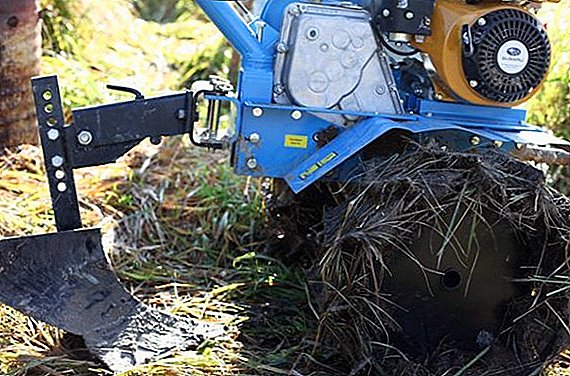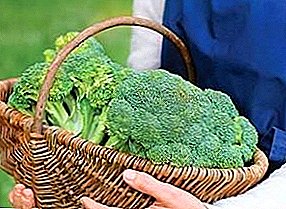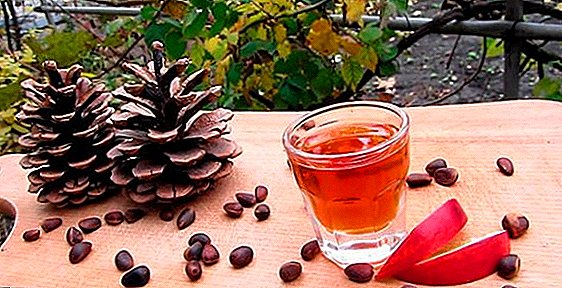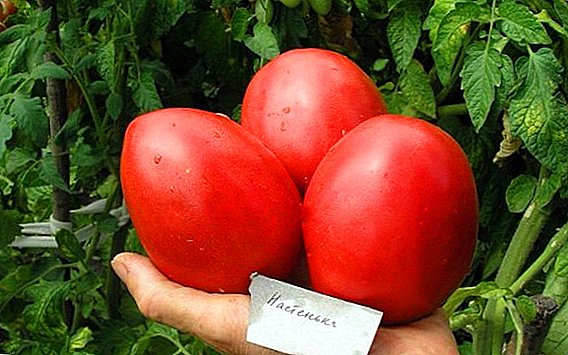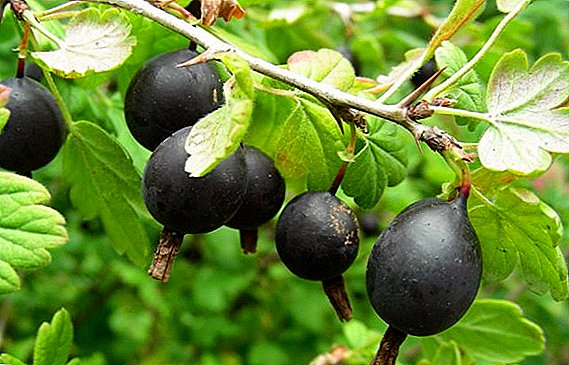 Yoshta is the name of a tall fruit shrub with black berries that resemble a cherry in size. Yoshta is a close relative of currant, sour-sweet berries have a slight taste of nutmeg and, which is especially nice, do not crumble like ripened currants.
Yoshta is the name of a tall fruit shrub with black berries that resemble a cherry in size. Yoshta is a close relative of currant, sour-sweet berries have a slight taste of nutmeg and, which is especially nice, do not crumble like ripened currants.
The fresh fruits of yoshta are an excellent delicacy, but these berries can also be prepared for the winter as jam, confiture, compote, either in dried or fresh frozen form. High taste qualities determine the widespread use of yoshta in cooking, its berries give a completely new taste to even familiar, it would seem, dishes.
Caloric and chemical composition of yoshta
Yoshta berries contain sugar (about 7%), organic acids, pectin, and anthocyanins - pigment substances of the glycoside group. Of the chemical elements that make up the yoshta, first of all it should be called iron, potassium, iodine and copper. Also Yoshta is rich in vitamins - especially a lot of vitamin C and P.  As can be seen from the table, yoshta has an extremely low calorie content, which allows it to be successfully used in dietology, as well as for the prevention and treatment of digestive disorders.
As can be seen from the table, yoshta has an extremely low calorie content, which allows it to be successfully used in dietology, as well as for the prevention and treatment of digestive disorders.
Did you know? Currants about the size of gooseberries and not prickly - myth or reality? The great breeder Michurin managed to realize this dream only partially: the variety of dark-purple gooseberry he bred was called “Black Moor”. At the same time, similar experiments were conducted in Germany, but the beginning of the Second World War prevented the work and postponed it for three decades. And in 1970, the world was finally presented a hybrid plant, corresponding to the long-time dream of breeders.Energy characteristic of yoshta
| Content, g | Calorie, kcal | Energy ratio,% | |
| Squirrels | 70 | 30 | 6 |
| Fat | 20 | 20 | 4 |
| Carbohydrates | 910 | 360 | 81 |
Useful properties of yoshta
Yoshta is a hybrid of gooseberry, gooseberry and black currant. Scientists managed not only to increase the yield of currants while preserving all its useful properties, but also to give the new plant resistance to diseases affecting the parent species.
A hybrid is a name for plants obtained by crossing representatives of different varieties. For example, sharafuga is a hybrid of apricot, plum and peach, and emealina is a crossed blackberry and raspberry.
Separately, it should be noted that Yoshta has no thorn thorns inherent in the gooseberry, which was an additional bonus to the results of the work of German scientists under the direction of the breeder Rudolph Sauer.  The only thing that yoshta is slightly inferior to one of its "parents" - currants - is vitamin C content. However, if we recall that black currant is in the rating of "vitamin-C-containing" vegetable products (vegetables, fruits and berries) occupying an honorable third place (following the wild rose and sweet Bulgarian pepper), it becomes clear that it would be unfair to speak about the lack of vitamin C in the yoshta.
The only thing that yoshta is slightly inferior to one of its "parents" - currants - is vitamin C content. However, if we recall that black currant is in the rating of "vitamin-C-containing" vegetable products (vegetables, fruits and berries) occupying an honorable third place (following the wild rose and sweet Bulgarian pepper), it becomes clear that it would be unfair to speak about the lack of vitamin C in the yoshta.
But the fact that the harvest of the yoshta is not related to the bleeding scratches on the body that are inevitable when working with the gooseberry, it is impossible to call anything like good!
Did you know? The name "yoshta" is a combination of two words: currant (German Johannisbeere) and gooseberry (German Stachelbeere).The chemical composition of yoshta, the presence of valuable substances and elements in it determines the beneficial properties of the berry. In addition to the vitamins and trace elements necessary for the human body, the anthocyanins contained in its berries have the ability to kill bacteria, strengthen the walls of blood vessels and improve blood circulation.
 Phytoncides that the yoshta is rich in inhibit the growth and development of bacteria and fungi, so the berries are very useful as an anti-inflammatory, anti-cough and bactericidal agent.
Phytoncides that the yoshta is rich in inhibit the growth and development of bacteria and fungi, so the berries are very useful as an anti-inflammatory, anti-cough and bactericidal agent.The use of yoshta helps to normalize the functions of the gastrointestinal tract, the berries of the plant and the infusion of its roots have a binding effect in diarrhea. Along with pomegranate, yoshta increases the level of hemoglobin in the blood and is indicated for anemia, as well as for hypertension.
Finally, yoshta has the property of excreting heavy metal salts, toxins and even radioactive substances in moderate doses from the body, which makes the product incredibly useful, especially for residents of megalopolises.
Yoshta for weight loss
Yoshta contains a moderate amount of sugar and is considered a low-calorie product.that is already sufficient reason to include the berry in your diet without fear for the size of the waist. But there are additional reasons to use yoshtu for weight loss.  Thus, the anthocyanins with which the yoshta is rich accelerate metabolic processes in the body and, therefore, contribute to the rapid splitting ("burning") of fats.
Thus, the anthocyanins with which the yoshta is rich accelerate metabolic processes in the body and, therefore, contribute to the rapid splitting ("burning") of fats.
Pectins contribute to the improvement of intestinal microflora and the normalization of peristalsis. Cleansing the body, these substances also relieve excess weight.
In order to bring your weight back to normal, nutritionists recommend eating daily 0.5 to 0.7 kg of yoshta berries for 15 days. At the same time, of course, you should not jam a berry with a cake or a grilled chop.  In addition to using yoshta as a dietary supplement for weight loss, there are also special mono-diets based on this product. The table below shows an example of a ten-day diet that allows you to lose 3-4 kg of excess weight.
In addition to using yoshta as a dietary supplement for weight loss, there are also special mono-diets based on this product. The table below shows an example of a ten-day diet that allows you to lose 3-4 kg of excess weight.
Lose those extra pounds will help: broccoli, spinach, cardamom, Chinese cabbage, safflower, goji berries, horseradish, apples, barberry, cilantro.
Yoshta based diet
| First day | Second day | |
| Breakfast | 100 g of yoshta berries whole-grain bread loaf a piece of low-fat cheese | 200 g oatmeal 250 g yoshta compote |
| Dinner | 200 g yoshta berries 200 g low-fat cottage cheese | 200 g of yoshta berries 1 boiled chicken breast |
| Afternoon tea | 200 grams of yoshta berries | 200 grams of yoshta berries |
| Dinner | 2 cups kefir 2.5% | 200 g low-fat cottage cheese 250 g yoshta compote |
Preparation yoshty for the winter
Yoshta berries are amenable to processing and, if properly prepared, retain most of the nutrients.
Important! For successful harvesting yoshta berries better to collect a little unripe. In this form, the product retains its shape and during processing does not turn into a porridge. If yoshtu could not be collected on time, you can squeeze out juice from it, or by passing it through a meat grinder, make jelly, jam, confiture, etc.
A good way of harvesting yoshta berries for the winter entirely and without heat treatment is drying and freezing. These methods allow you to save the product in the most useful form, because, in addition to the absence of exposure to high temperature, from which many useful substances disintegrate, they are not associated with the addition of sugar to the berry and retain the dietary properties of yoshta.
Dried yoshta
Yoshta berries have a fairly dense skin that allows them to be well preserved during drying. Compote or decoction made from dried yoshta is invaluable in the winter diet to strengthen the immune system with a good dose of vitamin C.  Dried yoshtu can also be used as an additive in various dishes (for example, cupcakes or muffins, in which yoshta are added instead of raisins, they will acquire a new and original sweet-and-sour taste with a nutmeg shade). Finally, it is pleasant to nibble such a dryer just as a light snack: it is much more useful than cookies or sweets and is no less tasty.
Dried yoshtu can also be used as an additive in various dishes (for example, cupcakes or muffins, in which yoshta are added instead of raisins, they will acquire a new and original sweet-and-sour taste with a nutmeg shade). Finally, it is pleasant to nibble such a dryer just as a light snack: it is much more useful than cookies or sweets and is no less tasty.
Before drying, the yoshta berries need to be picked, washed and allowed to drain completely. Then the fruit spread on parchment and laid out in a well-ventilated place, protected from too bright sunlight. Drying time depends on temperature conditions, usually the procedure lasts several days.
Dried berries should not be completely dehydrated: a sign of readiness is the acquisition of elasticity by the fruits - they bend easily, juice is not emitted from them, but fruits should not be broken in the hands.  You can dry yoshtu in the oven, heated to 50-60 ° C. This is an accelerated process, it takes about 10-12 hours, but the condition of the fruit must be carefully monitored and periodically turned over. If individual berries begin to shrink sharply and become similar to embers, the temperature should be lowered immediately.
You can dry yoshtu in the oven, heated to 50-60 ° C. This is an accelerated process, it takes about 10-12 hours, but the condition of the fruit must be carefully monitored and periodically turned over. If individual berries begin to shrink sharply and become similar to embers, the temperature should be lowered immediately.
After drying, the yoshta is laid out in glass jars, paper or linen bags and stored in a dry place with occasional airing. If storage technology is observed, dry yoshta is usable for two years (however, it is better to use stocks before the start of the next season.
Frozen Yoshta
Freezing is the second, no less popular way of preparing yoshta. To maximize the preservation of all the beneficial properties of this procedure should be done with the newly collected fruits.
Learn how to freeze apples, strawberries, green peas, blueberries, pumpkins for the winter.
 Berries as well as for drying, sorted, washed and dried well. Fruits in a single layer are laid out on flat pallets and placed in a freezer for deep fast freezing. After a day, they can be laid out in special freezer bags or glass containers and stored in the freezer until use (during the whole winter and the subsequent spring, the berries retain their taste and beneficial properties).
Berries as well as for drying, sorted, washed and dried well. Fruits in a single layer are laid out on flat pallets and placed in a freezer for deep fast freezing. After a day, they can be laid out in special freezer bags or glass containers and stored in the freezer until use (during the whole winter and the subsequent spring, the berries retain their taste and beneficial properties).
Important! It is impossible to re-freeze thawed berries: moisture starts to stand out from them, the product loses its taste and useful qualities and becomes like a squeezed rag. In order to avoid such an effect, the yoshtu needs to be laid out in small portions, however, the correct freezing does not allow the berries to stick together, and the number of fruits that are necessary for use can always be removed from the freezer.The second method of freezing involves pouring washed and dried berries with sugar. In this case, yoshtu can be immediately frozen by filling the container with berries. This method seems to be less effective, since it limits the ways of using thawed berries - you can make sweet compote from it, but you will not add it as an ingredient in such dishes as, for example, meat sauce.
Contraindications and harm yoshty
 Yoshta has numerous beneficial properties, but there are also contraindications to the use of these berries.
Yoshta has numerous beneficial properties, but there are also contraindications to the use of these berries.
There are people who are allergic to vitamin C. Since there is a lot of ascorbic acid in yoshte, these people should limit their use. Individual intolerance to gooseberry or black currant is a sure sign that your body will also take yoshtu very badly.
Tendency to thrombosis is a contraindication for the abuse of yoshta.
Doctors do not recommend using yoshtu (like currants) for colitis, gastric ulcer and duodenal ulcer, gastritis and some other gastric problems - this can lead to aggravation.
With caution to Yoshte, especially in a concentrated form (fresh juice), should be applied to women during pregnancy.  Thus, the use of yoshta can bring both benefit and harm. Even being absolutely healthy people, one should always remember the wise saying about the medicine in the spoon and the poison in the cup.
Thus, the use of yoshta can bring both benefit and harm. Even being absolutely healthy people, one should always remember the wise saying about the medicine in the spoon and the poison in the cup.
Observe the measure - and it will save you from troubles and health problems!



